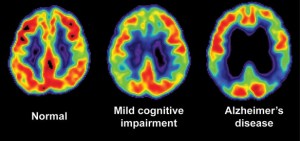
image: http://www.123rf.com/photo_15688227_alzheimer-disease-brain-tissue-with-amyloid-plaque.html
However, typically brain scans are the preferred method if doctors are suspicious as this a much less invasive way of diagnosing AD. By comparing the brain activity of an Alzheimer's brain to a normal brain, the presence of AD can readily be observed. This picture shows the clear difference between a normal brain and one with AD.

Image: http://www.berkeley.edu/news/media/releases/2009/07/14_alzheimers.shtml
To put the degenerative effects of Alzheimer's disease into perspective here is a comparison of a normal brain vs one affected by Alzheimer's. You can see how much the brain shrunk because neural tissue died.
Image: http://blogs.atribuna.com.br/maissaude/wp-content/uploads/2015/08/alzheimer.jpg
Source: Porth, C., & Porth, C. (2007). Essentials of Pathophysiology: Concepts of Altered Health States (2nd ed.). Philadelphia: Lippincott Williams & Wilkins

No comments:
Post a Comment